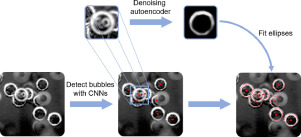当前位置:
X-MOL 学术
›
Int. J. Multiphase Flow
›
论文详情
Our official English website, www.x-mol.net, welcomes your
feedback! (Note: you will need to create a separate account there.)
Bubble Recognition Using Neural Networks: Application to the Analysis of a Two-Phase Bubbly Jet
International Journal of Multiphase Flow ( IF 3.6 ) Pub Date : 2020-05-01 , DOI: 10.1016/j.ijmultiphaseflow.2019.103194 Igor Poletaev , Mikhail P. Tokarev , Konstantin S. Pervunin
International Journal of Multiphase Flow ( IF 3.6 ) Pub Date : 2020-05-01 , DOI: 10.1016/j.ijmultiphaseflow.2019.103194 Igor Poletaev , Mikhail P. Tokarev , Konstantin S. Pervunin

|
Abstract Gas-liquid two-phase bubbly flows are found in different areas of science and technology such as nuclear energy, chemical industry, or piping systems. Optical diagnostics of two-phase bubbly flows with modern panoramic techniques makes it possible to capture simultaneously instantaneous characteristics of both continuous and dispersed phases with a high spatial resolution. In this paper, we introduce a novel approach based on neural networks to recognize bubble patterns in images and identify their geometric parameters. The originality of the proposed method consists in training of a neural network ensemble using synthetic images that resemble real photographs gathered in experiment. The use of neural networks in combination with automatically generated data allowed us to detect overlapping, blurred, and non-spherical bubbles in a broad range of volume gas fractions. Experiments on a turbulent bubbly jet proved that the implemented method increases the identification accuracy, reducing errors of various kinds, and lowers the processing time compared to conventional recognition methods. Furthermore, utilizing the new method of bubbles recognition, the primary physical parameters of a dispersed phase, such as bubble size distribution and local gas content, were calculated in a near-to-nozzle region of the bubbly jet. The obtained results and integral experimental parameters, especially volume gas fraction, are in good agreement with each other.
中文翻译:

使用神经网络进行气泡识别:在两相气泡射流分析中的应用
摘要 气液两相气泡流存在于不同的科学技术领域,如核能、化学工业或管道系统。使用现代全景技术对两相气泡流进行光学诊断,可以同时以高空间分辨率捕获连续相和分散相的瞬时特性。在本文中,我们介绍了一种基于神经网络的新方法来识别图像中的气泡模式并识别其几何参数。所提出方法的独创性在于使用类似于实验中收集的真实照片的合成图像训练神经网络集成。将神经网络与自动生成的数据结合使用使我们能够检测重叠、模糊、和非球形气泡在广泛的气体体积分数范围内。在湍流气泡射流上的实验证明,与传统识别方法相比,所实施的方法提高了识别精度,减少了各种错误,并降低了处理时间。此外,利用新的气泡识别方法,在气泡射流的近喷嘴区域计算了分散相的主要物理参数,例如气泡尺寸分布和局部气体含量。所得结果与积分实验参数,特别是气体体积分数,吻合较好。与传统识别方法相比,减少了处理时间。此外,利用新的气泡识别方法,在气泡射流的近喷嘴区域计算了分散相的主要物理参数,例如气泡尺寸分布和局部气体含量。所得结果与积分实验参数,特别是气体体积分数,吻合较好。与传统识别方法相比,减少了处理时间。此外,利用新的气泡识别方法,在气泡射流的近喷嘴区域计算了分散相的主要物理参数,例如气泡尺寸分布和局部气体含量。所得结果与积分实验参数,特别是气体体积分数,吻合较好。
更新日期:2020-05-01
中文翻译:

使用神经网络进行气泡识别:在两相气泡射流分析中的应用
摘要 气液两相气泡流存在于不同的科学技术领域,如核能、化学工业或管道系统。使用现代全景技术对两相气泡流进行光学诊断,可以同时以高空间分辨率捕获连续相和分散相的瞬时特性。在本文中,我们介绍了一种基于神经网络的新方法来识别图像中的气泡模式并识别其几何参数。所提出方法的独创性在于使用类似于实验中收集的真实照片的合成图像训练神经网络集成。将神经网络与自动生成的数据结合使用使我们能够检测重叠、模糊、和非球形气泡在广泛的气体体积分数范围内。在湍流气泡射流上的实验证明,与传统识别方法相比,所实施的方法提高了识别精度,减少了各种错误,并降低了处理时间。此外,利用新的气泡识别方法,在气泡射流的近喷嘴区域计算了分散相的主要物理参数,例如气泡尺寸分布和局部气体含量。所得结果与积分实验参数,特别是气体体积分数,吻合较好。与传统识别方法相比,减少了处理时间。此外,利用新的气泡识别方法,在气泡射流的近喷嘴区域计算了分散相的主要物理参数,例如气泡尺寸分布和局部气体含量。所得结果与积分实验参数,特别是气体体积分数,吻合较好。与传统识别方法相比,减少了处理时间。此外,利用新的气泡识别方法,在气泡射流的近喷嘴区域计算了分散相的主要物理参数,例如气泡尺寸分布和局部气体含量。所得结果与积分实验参数,特别是气体体积分数,吻合较好。











































 京公网安备 11010802027423号
京公网安备 11010802027423号